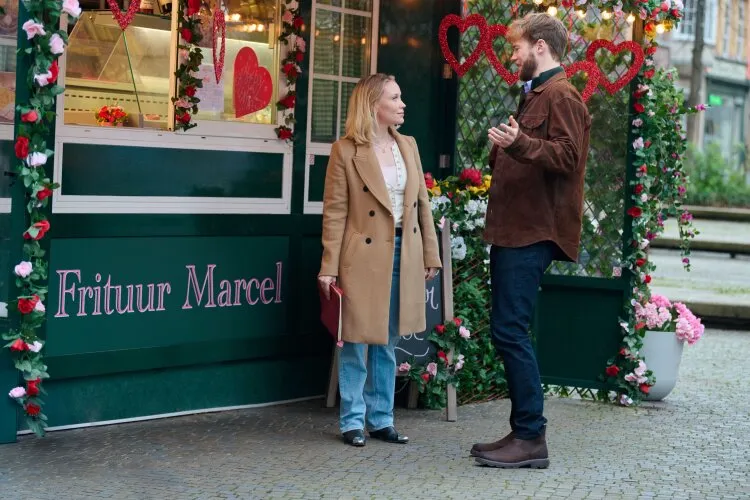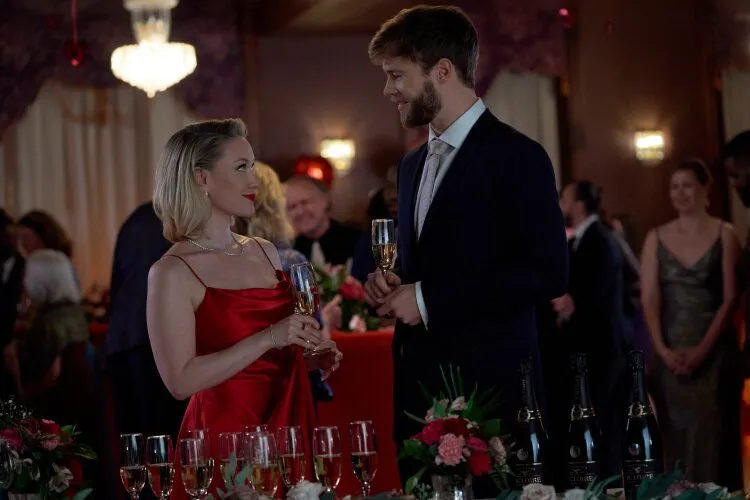In a crisp winter setting in Belgium, the film offers a heartfelt escape steeped in romance, family ties, and the passion of a well-worn trade. The story centers on a determined jewelry designer from Chicago who finds herself in Antwerp, striving to rescue her grandfather’s long-standing business.
The narrative unfolds as she faces both the challenges of an inherited legacy and the unexpected pull of a budding connection, set against the backdrop of a competitive design contest.
The film’s premise is simple yet engaging: a young creative spirit ventures into a world where old-fashioned traditions meet modern commercial pressures. The backdrop of Antwerp provides an atmospheric stage, capturing the charm of a European city with its storied history and artistic allure.
This production bears the marks of skilled direction and collaborative scriptwriting by industry veterans whose experience lends a sense of assurance and authenticity to the dialogue and character interactions.
Led by actors whose previous roles have earned them admiration, the film’s cast imbues their parts with warmth and reliability. The tone remains upbeat and sincere, with moments of tension emerging from clashes in business ideals. As a film that reflects the evolution of narrative structures and the meeting of varied cinematic influences, it offers much for both devoted cinephiles and casual viewers alike.
Plot Summary and Narrative Structure
Abby, a struggling jewelry designer in Chicago, receives an unexpected call that changes her direction completely. The invitation to travel to Antwerp sets the stage for a tale of personal revival and the fight to rescue her family business.
The narrative centers on her dual mission: reviving a fading legacy while competing in a high-stakes design contest that promises both financial relief and professional recognition.
The spark of the story occurs with Abby’s decision to accept the challenge from Belgium. Upon her arrival, a meeting with Alexander—a representative from a competing firm—creates an immediate contrast in outlooks.
Their encounter stirs tension as their differing methods in jewelry design come to light, resulting in moments that mix personal spark with professional rivalry. In this mix, the roles of secondary characters, including a loyal friend and a demanding boss, further enrich the storyline by adding emotional depth and practical obstacles.
As the plot unfolds, the build-up to the Valentine’s Day Diamond Contest forms a turning point. The contest acts as the arena where personal ambitions clash with the pressure of familial expectations.
The film uses this event to layer ethical dilemmas and secret strategies that test the characters’ integrity and resolve. Several sequences capture the mounting pressure, offering a closer look at the choices that define both the career paths and personal lives of those involved.
I have found that the film’s narrative method recalls the inventive storytelling techniques seen in films by directors such as Godard and Truffaut, while also echoing the straightforward charm present in modern works by filmmakers like Noah Baumbach. This approach makes the story engaging for audiences seeking both a relatable human story and an exploration of inventive cinematic structure.
Character Analysis and Performances
Abby Vanderbrink is presented as a driven jewelry designer with a strong commitment to her craft. She faces a personal struggle as she balances the expectations of her family’s long-established methods with her own desire to explore fresh design ideas.
Throughout the film, Abby evolves in a way that highlights her perseverance and willingness to experiment. Her determination fuels the story, with each decision she makes pushing her to question established practices while striving for professional recognition.
Alexander plays a dual role that adds an interesting twist to the narrative. He functions both as a competitor and as a potential ally in Abby’s journey. His modern approach to business sharply contrasts with the more traditional techniques that Abby holds dear.
This conflict creates moments of tension that reveal his moral growth and add complexity to his character. His decisions, particularly when faced with difficult ethical choices, hint at a personal evolution that gives him depth and makes his interactions with Abby feel genuine and thought-provoking.
Supporting characters also contribute significantly to the film’s texture. Abby’s grandfather, Laurent, is depicted as a kind yet overwhelmed figure. His challenges and personal losses provide a heartfelt counterpoint to the professional dilemmas Abby confronts, deepening the emotional core of the story.
Meanwhile, Abby’s trusted friend offers practical advice and emotional support, serving as a grounding force amid the unfolding drama. A brief glimpse at Abby’s boss shows the pressures that come with a reputation in an industry that often overlooks emerging talent.
The performances throughout the film are delivered with subtlety and care. Moments where characters share quiet exchanges reveal hidden emotions, and these instances add a layer of sincerity to their interactions.
The chemistry between Abby and Alexander is especially notable, sparking conversations that feel both authentic and reflective of current shifts in cinematic storytelling, reminiscent of approaches found in the work of directors I admire from both the French New Wave and today’s cinema landscape.
Themes, Symbols, and Subtext
The film presents the family jewelry business as a signifier of tradition and heritage, setting the stage for a conflict between preserving long-standing values and adapting to new practices. Abby’s struggle to honor a storied legacy while pursuing fresh creative ideas reflects a broader generational tension.
The family shop is not merely a setting but serves as a visual marker of the challenges that arise when time-tested methods meet current expectations.
“Home Is Where the Heart Is” is a phrase that recurs throughout the film, carrying both a literal and a figurative weight. The idea of home extends beyond a physical space, touching on inner feelings and a sense of belonging. Abby’s choices throughout the narrative expose a personal reckoning with identity, suggesting that personal growth is intertwined with the efforts to secure the family business.
The tension between traditional craftsmanship and modern technology emerges clearly in the film’s approach to jewelry design. This opposition stands as a commentary on the pressures of balancing established techniques with innovative tools—a conversation that is very much alive in today’s creative industries.
The evolving rapport between Abby and Alexander captures another layer of meaning. Their partnership on the design contest symbolizes a synthesis of artistic vision and business acumen, demonstrating that differences in perspective can lead to a richer creative process.
Meanwhile, subtle narrative choices and moral decisions hint at wider discussions about industry expectations and the struggles creative professionals face in meeting them, adding depth to the film’s portrayal of contemporary challenges.
Production Elements and Aesthetic Choices
The film’s visual narrative plays a significant role in creating an immersive experience. The cinematography captures the quaint charm of Antwerp while contrasting it with the busy, confined urban feel of Chicago.
The camera work uses natural light to emphasize the cool, crisp atmosphere during wintry scenes, lending a sincere air to the visuals. Careful composition highlights both the fine details of the jewelry and the expansive cityscapes, making every frame a part of the storytelling.
The set design reinforces the narrative with thoughtful attention to detail. The family jewelry store exudes a nostalgic charm through warm textures and traditional decor that speak to its long history.
In contrast, the competitor’s space stands out with a streamlined look that reflects modern aesthetics and efficiency. Costume choices further reveal character traits—Abby’s attire blends practicality with hints of creative flair, while Alexander’s wardrobe showcases a refined, contemporary style.
The film’s auditory experience is equally considered. The musical score aligns with the emotional flow, shifting from soft, reflective tunes during intimate moments to livelier tracks during animated exchanges. Ambient sounds and local musical elements transport the viewer to Belgium, enriching the film’s cultural setting.
On-location shooting in Belgium brings an authentic quality to the production. Recognizable landmarks and genuine local scenes blend seamlessly with crafted studio sequences, ensuring the film feels both polished and true to its setting.
Dialogue, Pacing, and Storytelling Techniques
The film’s dialogue is sharp and engaging, with moments of witty exchange between Abby and Alexander that reveal their contrasting views while hinting at a mutual respect.
Their repartee carries a playful tone that eases moments of tension, infusing humor into situations that might otherwise feel heavy. This interplay adds a layer of charm to the overall narrative, drawing the viewer into their evolving connection.
The narrative maintains a steady rhythm from start to finish, with a smooth progression from the initial setup through rising challenges to climactic moments. Occasional scenes may feel a bit slow, but these pauses are balanced by sequences that quickly shift the energy, keeping the viewer attentive. The film makes effective use of visual cues and subtle details to show the story, reducing reliance on explicit dialogue.
Smaller story threads enrich the central plot without overwhelming it. Key scenes, where a shift in tone or pace marks a turning point in both the personal and business aspects of the story, are particularly memorable. These moments highlight the strength of the film’s editing and the careful planning of its dramatic beats, ensuring that the emotional stakes remain clear and engaging throughout the experience.
The Review
The Perfect Setting
The film offers a warm, engaging story marked by clever dialogue, thoughtful visuals, and genuine character development. Its interplay between traditional values and modern perspectives provides a pleasant experience that captures both emotion and humor. The pacing is well-managed, with key moments that truly shine, even if some parts feel slower. Overall, it remains an enjoyable and refreshing take on its genre.
PROS
- Authentic portrayal of family legacy
- Thoughtful balance of humor and emotional depth
CONS
- A few narrative twists feel conventional
- Limited exploration of deeper themes




















































